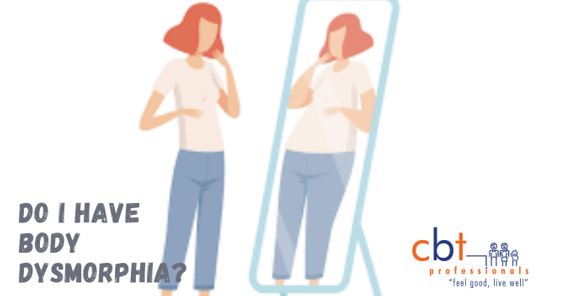Do I Have Body Dysmorphia?
Body dysmorphia is more than just feeling insecure about your appearance. We firstly all have something we would like to change about ourselves. We all have days where we look in the mirror and feel a bit down. However, the obsession over your appearance and fixation over flaws that need to be ‘fixed’, means you possibly could be suffering from Body Dysmorphic Disorder (BDD). This blog examines what body dysmorphia is, how you can recognise it and how to help manage.
WHAT IS BODY DYSMORPHIA?
Body dysmorphic disorder is a mental health disorder where you are unable to stop thinking about ‘defects’ or ‘flaws’ in your appearance. These flaws can be minor or not seen by others. Firstly, you may feel ashamed, or embarrassed in social situations. Secondly, you can focus on your body image and appearance intensely. Such as checking mirrors, seeking approval and reassurance, and grooming constantly. These flaws cause you distress and can overall impact everyday life. BDD is an obsessive-compulsive disorder that involves mostly depression and social avoidance. It is also generally associated with Social Anxiety Disorder.
10 SIGNS YOU MAY BE DEALING WITH BODY DYSMORHPIA
BDD is characterized by multiple activities aimed at reducing, hiding, or checking the ‘flawed’ area. The acts are compulsive and/or repetitive. Mainly the areas of focus most commonly are the face, skin, and hair. If you experience BDD, you could spend hours thinking about your ‘flaw’, using social avoidance, or cosmetics/apparel to camouflage yourself. These practices increase anxiety and enforce ‘steps’ that will maintain our current appearance.
Compulsive routines could include:
RE ASSURANCE
- Asking others for their opinions on your appearance or refuse to talk about appearance at all.
- Comparing photos taken in the past to check and enforce there has been no change.
CHECKING & THINKING
- Spending lots of time in the mirror/avoid mirrors completely.
- Looking at other people and compare yourself.
- Spending lots of time thinking/worrying about your appearance
- Feeling the feature with your fingers
AVOIDENCE
- You alter your schedules due to fear and anxiety of your appearance.
- Prefer the night and avoid daylight/sunlight
- Avoid photos and videos
- Don’t like mirrors and avoid them
CAMOUFLAGE
- Wearing baggy clothes or hats/scarves to hide features
- Wearing excessive makeup
- Styling hair in specific ways
REPETITVE BEHAVIOURS
- Your eating and fitness habits are often extreme.
- Hair removal
- Constant skin picking
- Grooming
- Specific beauty routines, such as washing face etc.
WHAT ARE THE RISKS OF BODY DYSMORPHIA?
BDD may result from a combination of issues. These could include family history, negative experiences about self-image or abnormalities in the brain. Predominately, BDD starts in teenage years for males and females. In these early years a multitude of factors could increase the risk. Including negative life experiences like bullying, certain personality traits, societal pressure and/or having relatives with a similar disorder.
There are a high number of complications that come with BDD. These can include firstly depression, suicidal thoughts and behaviour. Secondly, disorders such as anxiety & eating disorders, health problems, or lastly physical pain can develop. For this reason, help should be sought early.
HOW TO MANAGE BODY DYSMORPHIA?
The constant use of social media has heavily translated into body dysmorphia tendencies – especially in adolescences. This makes it difficult to manage BDD as we are constantly shown things that we perceive as better. Specifically, females’ mental health has been most affected by exposure to social media. The most common result of BDD in females is low self-esteem and negative self-evaluation.
Managing BDD can be difficult. However, not impossible. Body dysmorphia predominately leaves individuals to isolate themselves. Avoiding self-isolation and reaching out to loved ones for support is a first step. Writing in a journal daily can take the step of expressing our thoughts and emotions without acting on them. Our minds trick us into changed perceptions of what is real, so practicing perspective is essential.
While all these methods can help take the first step, it is just the first step. Professionals can implement healthy techniques for negative thoughts.
Lastly, if you or someone you know is struggling, you can contact the Butterfly Foundation for help on 1800 33 4673. If it is a crisis and urgent, please contact Lifeline on 13 11 14 or Police and Ambulance on 000.
CONTACT US
Additionally, if you are wanting support and management of BDD, consulting with a psychologist may help. If you wish to consult with a CBT Professionals psychologist, please download referral form here and take it with you to your GP appointment for preparation of a referral.
Disclaimer: Content on this website is provided for education and information purposes only and is not intended to replace advise from your doctor or registered health professional. Additionally, readers are urged to consult their registered practitioner for diagnosis and treatment for their medical concerns.
REFERENCES
Smith, Waterman & Veale. (2019). Recognizing and managing body dysmorphic disorder. The Pharmaceutical Journal. https://pharmaceutical-journal.com/article/ld/recognising-and-managing-body-dysmorphic-disorder
THREE CONVENIENT LOCATIONS
MOUNT GRAVATT
Mt Gravatt Medical PrecinctSE 105, 1808 Logan Rd
Upper Mount Gravatt QLD 4122


